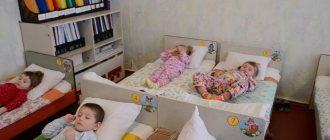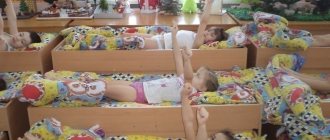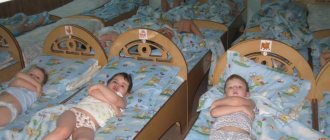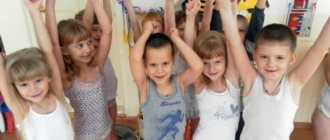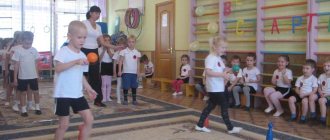Elements of gymnastics after sleep
Gymnastics after sleep is like a multi-colored mosaic that can be reassembled every day, creating a new image from its main elements. Daytime gymnastics, as an option, may include:
- stretching;
- breathing exercises;
- swing your arms;
- stroking biologically active zones;
- jumping;
- squats;
- simple elements of yoga;
- finger gymnastics;
- gymnastics for the eyes;
- visual-acoustic exercises.
Despite the fact that gymnastics after sleep is usually short-lived, the teacher can combine individual elements and use the developments he likes in fragments.
Video example of morning exercises:
Types of gymnastics after sleep
In the methodological developments proposed by experts, the following types of gymnastics after sleep can be distinguished:
- exercises in bed with elements of self-massage;
- play gymnastics;
- gymnastics with exercise equipment and sports equipment;
- walking or jogging on massage mats/paths.
When preparing the exercise, you can use any exercise equipment that is available in the kindergarten
. As can be seen from the list, daytime gymnastics becomes a powerful set of health procedures, competently and concisely structured in time, and most importantly, interesting and enjoyable for the child.
All exercises are carried out in stages, with a gradual increase in load, and are of a playful nature. They are aimed at general strengthening of the body, prevention of disorders of posture, vision and flat feet. Psychologically, gymnastics classes unite children in a group and help them get out of the state of internal stiffness into which, as if in a capsule, the baby is immersed during sleep.
The teacher is free to choose specific exercises. He independently assesses the capabilities and needs of his students, observes which exercises are especially loved by children and, if desired, varies the tasks so as not to turn the magic of the five-minute sports session into a routine.
Gymnastics for waking up after a nap in the middle group
Gymnastics for waking up after a nap in kindergarten.
Middle group Author: Nadezhda Nikolaevna Trunicheva, teacher, School 947, Moscow. Description of material: I offer you gymnastics for waking up after a nap for preschool children. This material will be useful to teachers of all age groups and physical education directors of kindergartens. Quiet time is an integral part of the daily routine of preschool children. After it, children wake up rested and with new strength. It is important to gradually include children in active activities, moving them from a state of inhibition to wakefulness. But each child has his own characteristics of awakening. Some children get up after a nap cheerful and cheerful. Others remain half asleep for a long time. Awakening gymnastics in kindergarten is precisely designed so that children of any age can painlessly, without tears and whims, move from daytime sleep to full-fledged play activities. Gymnastics after a nap helps the child’s body wake up, improves mood, and improves muscle tone. It is aimed at the gradual transition of children from sleep to wakefulness. During gymnastics, musical accompaniment is advisable. Music has a positive effect on children's emotions, creates a good mood in them, instills cheerfulness and joy, helps the rhythm of movements, and makes them easier to perform. Gymnastics (Greek gymnastike, from gymnazo - I train, exercise) is a system of specially selected physical exercises, methodological techniques used to improve health, improve a person’s motor abilities, strength, agility, endurance. These exercises allow you to influence either the entire body or promote the development of individual muscle groups and organs. Next, I offer you several awakening gymnastics complexes. 1st complex 1. “Stretch”. Starting position: lying on your back, arms along your body, stretching. 2. Starting position: lying on your back, arms along your body, inhale, sit with straight legs, hands to your toes, exhale, inhale, starting position. 3. Starting position: standing, feet shoulder-width apart, hands below, inhale, exhale, tilt the torso forward, inhale, starting position, exhale, tilt. 4. Starting position: standing, feet shoulder-width apart, arms below, inhale, arms to the sides, exhale, tilt the torso to the right, inhale, exhale, tilt the torso to the left. 5. Starting position: standing, feet shoulder-width apart, hands behind your head, inhale - rise on your toes, exhale - squat. 6. Starting position: standing, feet shoulder-width apart, arms along the body, inhale, arms through the sides up, rise on your toes, exhale, starting position. 2nd complex 1. Starting position: lying on your back, arms along the body. Bend your knees, pull your legs to your chest, clasp your knees with your hands, return to the starting position. 2. Starting position: lying on your back, hands behind your head, legs bent at the knees. Tilt your knees to the left, to the starting position, tilt your knees to the right, to the starting position. 3. Starting position: sitting, legs together, arms supported at the back. Bend your knees, pull them to your chest, with the sound “f-f” - exhale, starting position, inhale (through the nose). 4. Starting position: sitting, legs together, one hand on the stomach, the other on the chest. Inhale through the nose, drawing in the stomach; exhale through the mouth, inflating the stomach. 5. Starting position: standing, legs apart, arms down. Clap your hands - exhale; spread your palms to the sides - inhale. 6. Starting position: standing, legs apart, arms down. Stretching: reached to the ceiling, returned to the starting position. 3rd complex 1. Starting position: lying on your back, arms along the body, raise your arms up, stretch, arms forward, starting position. 2. Starting position: lying on your back, arms along your body, pull your toes towards you, starting position. 3. Starting position: sitting, legs straight, arms supported at the back, toes spread to the sides, starting position. 4. Starting position: sitting, legs straight, arms supported behind you, stepping with your toes, bending your knees, the same with straightening your legs. 5. Starting position: sitting, legs bent, arms supported behind your back, toes on your toes, left heel hitting the floor. 6. Starting position: standing, feet together, hands on waist, roll from toes to heels. 4th complex 1. “Stretch”. Starting position: lying on your back, arms along the body, stretching, starting position. 2. "Slide". Starting position: sitting, legs straight, arms supported behind, resting on the hands and heels of the straightened legs, raise the pelvis up, hold, return to the starting position. 3. "Boat". Starting position: lying on your stomach, arms up, bend over (raise your upper and lower torso), hold, return to the starting position. 4. "Wave". Starting position: kneeling, hands on your belt, sit to the right of your heels, hands to the left, starting position, sit to the left of your heels, hands to the right, starting position. 5. "Ball". Starting position: standing, feet together, jumping on two legs and tossing the ball in front of you. 6. Starting position: standing, feet shoulder-width apart, torso muscles relaxed. In complete silence, children listen to their own breathing and determine which part of the body moves when inhaling and exhaling (stomach, chest, shoulders in waves), quiet breathing or noisy breathing. 5th complex 1. Starting position: lying on your back, arms along your body, raise your right leg (straight), starting position, raise your left leg (straight), starting position. 2. Starting position: lying on your back, hands in front of you “holding the steering wheel”, “riding a bicycle”, starting position. 3. Starting position: lying on your back, arms up, turn your torso to the right without lifting your feet from the floor, start position, turn your torso to the left, start position. 4. Starting position: lying on your back, hands behind your head, bring your elbows together in front (elbows touching each other) - exhale, starting position, elbows touching the floor - inhale. 5. Starting position: sitting, legs crossed, hands on the belt, arms out to the sides, inhale, exhale. 6. Starting position: standing, feet shoulder-width apart, arms along the body, take correct posture without visual control (eyes closed), repeat 3-4 times. 6th complex 1. Starting position: lying on your back, arms along the body, raise your arms up, stretch, arms forward, starting position. 2. Starting position: lying on your back, arms along your body, pull your toes towards you, starting position. 3. Starting position: sitting, legs straight, arms supported at the back, toes spread to the sides, starting position. 4. Starting position: sitting, legs straight, arms supported behind you, stepping with your toes, bending your knees, the same with straightening your legs. 5. Starting position: sitting, legs bent, arms supported behind your back, toes on your toes, left heel hitting the floor. 6. Starting position: standing, feet shoulder-width apart, hands on waist, roll from toes to heels. 7th complex 1. Starting position: lying on your back, arms along your body, tense your body, inhale, hold for a few seconds, relax, exhale. 2. Starting position: lying on your back, arms to the sides, fingers clenched into fists, cross your arms in front of you, exhale, spread your arms, return to the starting position, inhale. 3. Starting position: lying on your back, hands behind your head, raise your left leg straight, raise your right leg straight, keep them together, starting position (lower at the same time). 4. Starting position: lying on your back, hands resting on your elbows, bend over, lift your chest up, keep your head straight (3-5 seconds), return to the starting position. 5. Starting position: lying on your stomach, hands behind your head, bend over, hands to your shoulders, legs on the floor, hold, starting position. 6. Starting position: lying on your stomach, hands under your chin, bend over, placing emphasis on your forearms, neck stretched - inhale, exhale. 8th complex 1. Starting position: lying on your back, arms along the body, raise your arms up, stretch, starting position. 2. Starting position: sitting, legs crossed (lotus position), massage of the big toes, starting from the pad to the base. 3. Starting position: the same, massage the fingers - from the nails to the base with pressure (internal and external). 4. Starting position: sitting, legs crossed (lotus position), arms forward, massage-stroking the arms - from fingers to shoulder. 5. Starting position: sitting, legs crossed (lotus position), close your eyes tightly for 5 seconds, open, repeat 5-6 times. 6. Starting position: standing, feet shoulder-width apart, hands on waist, walking in place with high knees. 9th complex 1. Starting position: lying on your back; legs are straight. Bend your knees and straighten them. 2. Starting position: lying on your back, arms along your body. Stretch, performing involuntary body movements. 3 Starting position: lying on your stomach, hands under your chin. Alternately place your head on your right shoulder, then on your left. 4. Starting position: lying on your stomach, hands under your chin. Raise your legs and dangle them. 5. Starting position: sitting. Raise your legs with your knees bent and swing them. 6. Starting position: sitting, hands on knees. Inhale, hold your breath, exhale 10th complex 1. Starting position: lying on your back, arms bent at the elbows in front of you. Alternately bend and straighten your legs, touching your elbows to your knees. 2. Starting position: lying on your back, arms bent at the elbows, legs at the knees. Flounder like a bug 3. Starting position: lying on your back, arms along your body. Inflate your stomach like a ball, hold the position without breathing for 2-3 seconds. 4. Starting position: sitting, legs crossed, hands on knees. Bend to the knees - alternately to the right, left. 5. Starting position: lying on your stomach, hands under your chin. Alternately place your head on your right shoulder, then on your left. 6. Starting position: sitting, hands on knees. Inhale, hold your breath, exhale.
We recommend watching:
Corrective gymnastics for children of the middle group Gymnastics after sleep for children of the older group Rhythmic gymnastics for children with disabilities Gymnastics after sleep in the middle group. Card index
Similar articles:
Morning exercises in the second junior group in a playful way
Morning exercises in kindergarten in the preparatory group
Exercises for different groups
Gymnastics after sleep in the younger group
Daytime sleep is longest in the younger group of kindergarten. It can be difficult for kids to wake up in a good mood. If they were in a deep sleep, they may not immediately realize where they are. Children cry, are capricious, refuse to get up, wash, or get dressed. Therefore, during the exercises, the emphasis is on the emotional component of gymnastics: the correct selection of music, speech accompaniment, harmonization of the general atmosphere of the lesson. The images that the teacher will create during the exercises should be attractive.
Set of exercises “Sunshine”
A ray of sunshine woke up in the sky, A ray of sunshine reached out to the window.
There, outside the window, twenty children lie together in cozy beds. (Children stretch while lying in bed)
Hey, wake up, girls, boys!
You need to wear a dress and pants! Where are your pens? (Raise their hands and shake them in turn)
Where are your legs?
(Raise their legs, take turns doing swings)
Now we’ll play with you a little!
Come on, imagine that summer has come: The city has woken up, Rubbing their eyes with their fists).
And the sun rose.
(Raise their arms above their heads and stretch).
That is great!
So, let's ride into the distance along the path on a bicycle! (Doing the “Bicycle” exercise)
We drove and drove... - We arrived at the mill!
(Doing the “Mill” exercise)
Then we went. We drove, we drove... - We arrived at the river.
Let's help your feet, Let's touch some water! (They get up from the cribs, lowering their legs one by one to the floor)
Ay, the water is cold!
Here is one leg... (They jump on the right leg)
But here is another leg, what a nimble one!
(They jump on their left leg)
We stood in the water, Swimmed, (I make movements with my hands imitating swimming) We dived... Oh, good!
(They do squats with their arms extended forward)
They stood up from heel to toe and walked out onto the sand together.
(On tiptoes they walk out of the bedroom into the common room, where massage mats have already been prepared)
They walked on sand - They stepped on pebbles.
Oh, it's hot! (They walk in place on rubber mats for 2 minutes)
And now we have risen,
(Converge in the center of the hall)
We hold hands together.
(Form a circle)
Stretched,
(Stretched),
Smiled.
(Smile at each other).
Finally we woke up!
Gymnastics after sleep in the middle group
Gymnastics for middle group students should include a larger number of exercises. It is aimed not only at the emotional unity of children, but also at the comprehensive improvement of the child’s body. Elements of breathing exercises are required. It is advisable to combine gaming techniques with a set of exercises to prevent visual impairment and posture.
